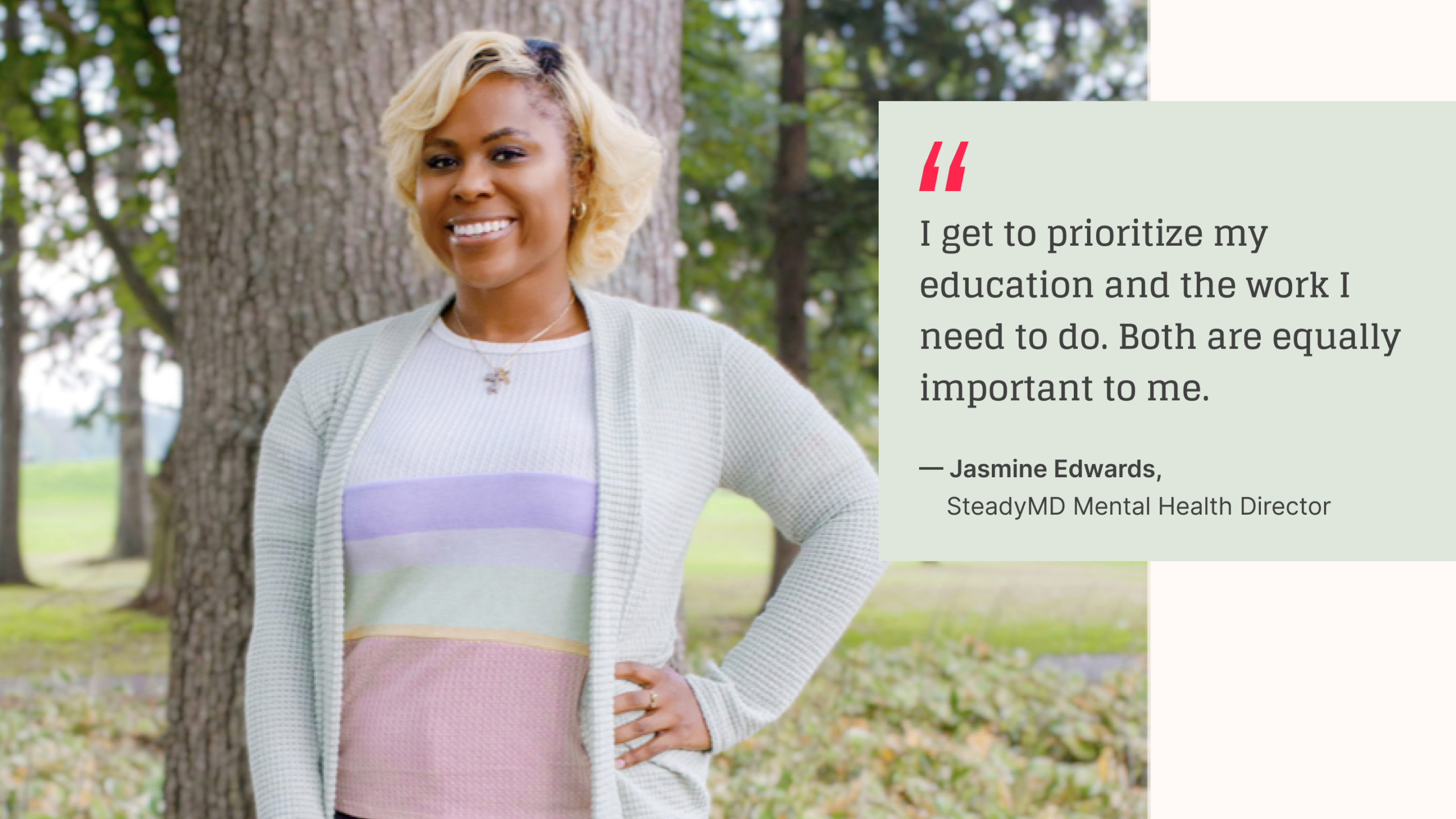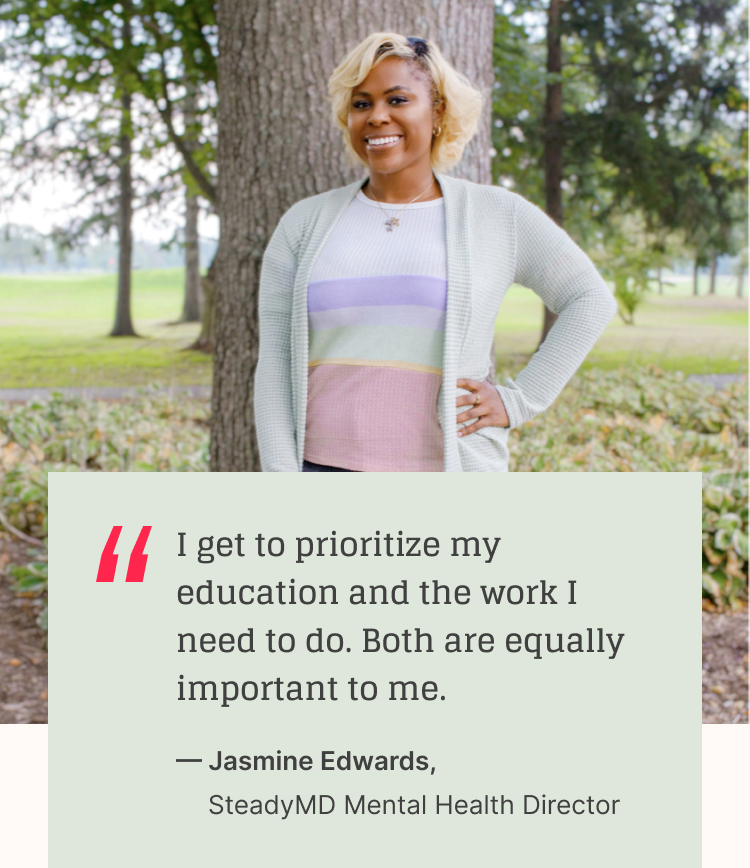Jasmine Edwards, LMHC
Mental Health Director, Forever Scholar, and Intersectionality Activist


At SteadyMD, we strive to find clinicians that meet a high standard of education, healthcare experience, ethical awareness, and patient empathy. Jasmine Edwards, LMHC and Mental Health Director for SteadyMD, fits that profile and more! She’s set ambitious goals for herself and continues to conquer every one of them. Jasmine educates those around her on causes important to her as she works toward her 5-year plan to become a psychiatric nurse practitioner, a profession with only 5.2% African Americans.1
Did you always want to pursue a career in the healthcare field?
No, it was my dream to be an FBI agent. In college, one of my professors was the late Harvey Schlossberg, Ph.D., founder of the New York Police Department’s psychological services division, where he pioneered treatment for violence-prone officers. Dr. Schlossberg trained more than 70,000 crisis negotiators globally and his innovative theories were adopted by the FBI and other law enforcement agencies. I learned so much from him. The career choice lost its appeal though after I realized I didn’t want to move across the country at a moment’s notice.
At the same time though, I became really interested in forensic psychology. After graduation, I went to Hunter College in New York to pursue a degree in mental health counseling. Fate took over from there. I graduated in 2015, and my boss at the time encouraged me to go to nursing school. I’m in nursing school now and I graduate in May 2022.
What is the difference between a nurse practitioner and a psychiatric nurse practitioner?
A nurse practitioner is a clinician. They see the patient, get to know them, do a full assessment, etc. I’m getting my BSN (Bachelor of Nursing) and then my doctorate focused on psychiatry, which will enable me to provide therapy and medication management.
A therapist can’t prescribe medication, and I’d like to do both. I love what I do (as a therapist), but I want to be able to touch the other side of mental health. It’s not represented enough for people of color, and there’s a great need for nurse practitioners of psychiatry in general.
What type of holistic approaches do you use with your clients?
As a trauma therapist, I use a lot of person-centered approaches, such as meeting you where you are. Therapy is a very vulnerable experience and this can especially be true for people of color so I always acknowledge that when I’m working with someone. I want to create a safe space and I let them set the pace. It needs to be a partnership — because if they don’t trust me, they aren’t going to stay with me. I’m a firm believer in physical activity, also referred to as Somatic Processing, which is how we feel and store feelings in our body. I also mix in evidence-based practices, such as CBT (Cognitive Behavioral Therapy) and DBT (Dialectical Behavioral Therapy).
“It’s all about changing your mindset to live a healthier life.”
You’re a firm believer in intersectionality. Can you explain what this is and why it’s important to you?
Intersectionality is an analytical framework for understanding how aspects of a person’s social and political identities combine to create different modes of discrimination and privilege. As a clinician of color, I’ve done a lot of research on what intersectionality looks like across America. It started two years ago, when I posted a question to my Facebook page and asked my friends this question: “If you were going to start therapy, does the color of your therapist matter?”
I got 150 responses within an hour. Obviously, people felt strongly about it. All my Caucasian friends said it didn’t matter. For them, gender mattered because they wouldn’t want to see a male therapist if they were seeking treatment for sexual trauma. However, all of my African American friends said it did matter, and they wouldn’t see someone who was Caucasian. I found this interesting because 90% of them had never been in therapy before. It made me wonder if race was a barrier to seek treatment for my African American friends and some of them acknowledged that it was.
“Talking about race and therapy is important. For instance, only 4% of therapists are African American.2 Obviously, that’s not enough for people of color.”
What prompted your move to virtual care?
I spent 16 months working for Northwell, the largest healthcare provider hospital on the east coast in emergency psychiatry. While there, I read a study of our data that reported people were waiting on average 72 hours to receive psychiatric care when visiting an in-person emergency room. My telepsychiatry team and I responded with action and were able to cover 16 of the Northwell hospitals’ needs virtually. That wait time of 72 hours went down to 90 minutes.
“We were seeing patients in a remarkable turnaround, and I realized at that point you can help more people by offering a virtual service.”
As much as I loved my job, I was working around-the-clock, and it took a toll on my body. I decided to leave and went back to in-person care. COVID-19 hit nine months later. I was able to see that people could get sober and get better virtually. For me, it was a no-brainer. If I could do the same level of work and see trauma patients (I’m EMDR-trained, which stands for Eye Movement Desensitization and Reprocessing), I could reach people who maybe don’t have a car or a way of accessing care in person. It was one of the easiest transitions I made in my career.
What caught your eye about SteadyMD? How did you know it was the right fit?
I had interviewed with other telehealth companies before, and the process felt mechanical and not personable. When I met SteadyMD’s Vice President of Program Operations, it felt authentic, like I was meeting a person that was part of a team that really cared about its employees. I saw the website and photos of people who worked here and enjoyed being here. Many of the doctors had been with the company for years, and that’s always a good sign.
What made me accept the job were the interview questions. There were questions about intersectionality and how I would treat patients of different sexual orientations or race. I had never been asked these questions before, so I knew the SteadyMD culture had to be different from past jobs.
What does a typical day at SteadyMD look like for you? How does it differ from your previous work?
So often, employers love having employees that are continuing their higher education until it comes to balancing their school schedule with their work schedule. I left my last job because I couldn’t keep up with the crazy hours of working a 9-5 job and going to school on weekends and evenings.
My 5-year plan is to become a psychiatric nurse practitioner. SteadyMD has given me the ability to see patients in the morning, go to school in the afternoon, answer calls and messages in between, and then go back to class. So, a typical day for me is very atypical, but it lets me reach my goals!
“My days are long, but I get to prioritize my education and the work I need to do. Both are equally important to me, and I don’t have to choose between them.”
Education is very important to you. Tell us why you refer to yourself as a forever scholar.
My parents often joke that I’ve taken maybe eight months off school since kindergarten! I’ve been in school “forever” because I went to grad school right out of college, and then I went to nursing school right after that.
“Psychiatrists and nurse practitioners of color are almost non-existent. That really motivates me to change the narrative of healthcare. I know that by pursuing my higher education, it’s for the greater good for people who look like me.”
Do you have a personal cause that you support/lend your voice to?
I think showing up for other communities that are going through a lot of shifts and changes–as we’ve seen happening the last couple of years–is important. For example, African American trans women are killed at an alarming rate. In the last year, there have been over 30 deaths in the United States. That’s something I’m very vocal about.
“You don’t need to be a part of a community to understand it and have empathy for it.”
What do you enjoy doing when you’re not working or in school?
I am a foodie. I recently went on a weekend getaway to Las Vegas. I was really looking forward to sampling some different cuisines at some new restaurants, but something unexpected and more exciting happened: I got engaged! My boyfriend proposed to me at the top of one of the world’s highest Ferris Wheels called the High Roller.